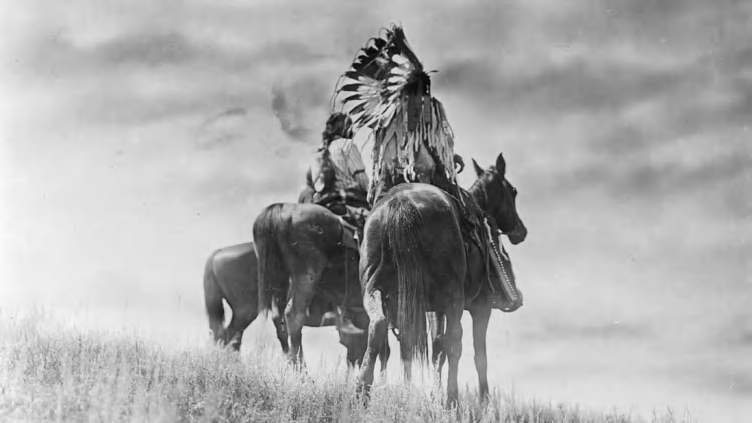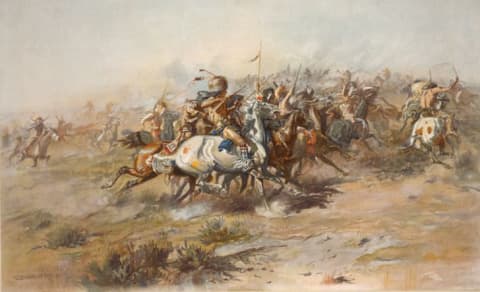Retrobituaries: Buffalo Calf Road Woman, Custer's Final Foe

For the Native Americans of the Northern Plains, the Battle of Little Bighorn was a glorious victory against U.S. government forces intent on claiming their land. Fought on June 25, 1876, in Montana Territory, the battle saw Lakota Sioux, Northern Cheyenne, and Arapaho warriors quickly overwhelm and kill some 260 U.S. troops. George Armstrong Custer, the Civil War hero sent to remove the Native Americans to their reservations, was among them.
Though the exact circumstances surrounding Custer’s death have long been the subject of debate, a new and intriguing account of his final moments surfaced in June 2005 when members of the Northern Cheyenne broke more than a century of silence to recount their tribe’s oral history of the battle. According to their account, it was a female fighter named Buffalo Calf Road Woman (alternately called Buffalo Calf Trail Woman) who knocked Custer off his horse that day, leaving him vulnerable, and who may have killed him.
Frank Rowland, a Cheyenne elder, told the Montana-based Independent Record, “The chiefs said to keep a vow of silence for 100 summers. One-hundred summers have now passed and we’re breaking our silence.” (In fact, almost 130 summers had passed by 2005.) The Northern Cheyenne said they had never publicly issued their account of the battle before because they feared retribution from the U.S. government.
The 2005 account wasn't the first mention of Buffalo Calf Road Woman at Little Bighorn, however. Thomas B. Marquis’s posthumous 1967 book Custer on the Little Bighorn includes the account of a female eyewitness who says: “Most of the women looking at the battle stayed out of reach of the bullets, as I did. But there was one who went in close at times. Her name was Calf [Road] Woman …[she] had a six-shooter, with bullets and powder, and she fired many shots at the soldiers. She was the only woman there who had a gun.”
Other details of Buffalo Calf Road Woman's life are scant. Most likely born in the 1850s, she was married to a warrior, Black Coyote, with whom she had two children. In the 1953 book Cheyenne Autumn, the Western historian and novelist Mari Sandoz describes her at the 1878 Battle of Punished Woman’s Fork in Kansas as both a mother and a warrior—“a gun in her hands, ready, the baby tied securely to her back.”
Her battlefield courage first cemented its place in tribal history about a week before Custer's Last Stand, at the June 17, 1876 Battle of the Rosebud, where the Cheyenne and Lakota tribes fought against the U.S. Army. There, Buffalo Calf Road Woman saved her brother—whose horse had been struck down—by charging on horseback into a melee of gunfire to rescue him. After that, the Cheyenne referred to the Battle of the Rosebud as the “Battle Where the Girl Saved Her Brother.”
Wallace Bearchum, Director of Tribal Services for the Northern Cheyenne, tells Mental Floss that her warrior exploits then surfaced at the Battle of Little Bighorn, where she fought “out in the open” instead of taking any cover, and where “she stayed on her horse the entire time.” Bearchum adds that although Buffalo Calf Road Woman was an “excellent markswoman,” she used a club-like object, not a gun, to knock Custer off his horse. It's not clear exactly what happened after that, but Bearchum says that Buffalo Calf Road Woman and other Cheyenne and Sioux women “finished off Custer and the other Calvary soldiers right after the battle was over," going "from soldier to soldier to finish them off or take things from them … remembering relatives killed by [U.S.] soldiers in previous attacks.”
"When [Custer] fell," Rowland explained to the Record in 2005, "he wasn't touched by the warriors because he was unclean. He was bad medicine." A scouting party found Custer's nude body two days later with two potentially fatal bullet holes, although we may never know for sure who caused them, or exactly which wound led him to lose his life.

No matter how brave she was, Buffalo Calf Road Woman was fighting a losing battle against the federal government. Doggedly pursued by U.S. troops, Buffalo Calf Road Woman, her warrior husband Black Coyote, and the other Cheyenne in their group had been on the run and were reaching the point of starvation. They were eventually relocated in the summer of 1877 to Indian Territory (present-day Oklahoma).
Finding themselves homesick and miserable in their new territory, however, they soon joined the Northern Cheyenne Exodus, which took place from the fall of 1878 to the spring of 1879, during which some 300 members of the tribe sought to return to their homeland in the northern part of the U.S.
Unfortunately, during the exodus, Black Coyote's personality changed: He became unhinged, flying into fits of hostility and brandishing a gun against his own people. He also stole horses that were property of the U.S. Army. When then confronted by a tribal elder, Black Coyote fatally shot him.
Buffalo Calf Road Woman’s husband was also a danger to outsiders. On April 5, 1879, a party he led ambushed two U.S. soldiers who were repairing a telegraph line in Montana Territory, killing one of them. When U.S. forces tracked down the party, Black Coyote had some of the slain soldier’s possessions on his person. He and two cohorts were arrested and in short order tried, convicted, and sentenced to be executed by hanging.
While this was going on, Buffalo Calf Road Woman’s own situation began to deteriorate. She had caught the “white man’s coughing disease,” also known as diphtheria, and died at some point in May 1879. Bearchum says he doesn't know the exact location of her burial, but explains that back then, the Cheyenne custom was to bury the dead immediately in the nearby hills. He thinks Buffalo Calf Road Woman was buried in the hills near what is now Miles City, Montana.
Although there is no monument to her, and Bearchum says “funding is needed” for further commemorations, she has been the subject of at least one prize-winning novel, by Rosemary and Joseph Agonito: Buffalo Calf Road Woman: The Story of a Warrior of the Little Bighorn.